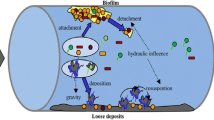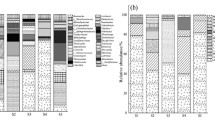Abstract
As a result of pollution in the present water sources, cities have been forced to utilize cleaner water sources. There are few reports regarding the potential shift of bacterial community structure driven by water source switching, especially that of corrosion-related bacteria. Three types of finished water were used for simulation, the polluted source water from the Qiantang and Dongtiaoxi Rivers (China) was replaced by cleaner water from Qiandao Lake (China). Here, we discussed the transition effects through three simulated reactors. The bacterial characteristics were identified using the high-throughput sequencing and heterotrophic plate count method. It was observed that the level of culturable bacteria declined by 2–3 orders of magnitude after water source switching. The bacterial community released from the pipeline reactor was significantly different under different finished water, and it exhibited large variation at the genus level. Porphyrobacter (58.2%) and Phreatobacter (14.5%) clearly replaced Novosphingobium, Aquabacterium, and Cupriavidus as new dominant genera in system A, which could be attributed to the lower carbon and nitrogen content of the new water source. Although corrosion-inhibiting bacteria decreased after switching, they still maintained dominant in three reactors (6.6%, 15.9%, and 19.7%). Furthermore, potential opportunistic pathogens such as Sphingomonas were detected. Our study shows that after transition to a high quality water source, the total culturable bacteria released was in a downtrend, which leads to a great reduction in the risk of bacterial leakage in the produced drinking water.

Similar content being viewed by others
References
APHA (2005). Standard Methods for the Examination of Water and Wastewater, 21st ed. Washington, DC: American Public Health Association, American Water Works Association, and Water Environment Federation
Chen L H, Ling F Q, Bakker G, Liu W T, Medema G, Van Der Meer W, Liu G (2020). Assessing the transition effects in a drinking water distribution system caused by changing supply water quality: an indirect approach by characterizing suspended solids. Water Research, 168: 115159
Edgar R C (2013). UPARSE: highly accurate OTU sequences from microbial amplicon reads. Nature Methods, 10(10): 996–998
Emde K M E, Smith D W, Facey R (1992). Initial investigation of microbially influenced corrosion (MIC) in a low-temperature water distribution-system. Water Research, 26(2): 169–175
Favere J, Buysschaert B, Boon N, Gusseme B D (2020). Online microbial fingerprinting for quality management of drinking water: Full-scale event detection. Water Research, 170: 115353
Gagnon G A, Rand J L, O’leary K C, Rygel A C, Chauret C, Andrews R C (2005). Disinfectant efficacy of chlorite and chlorine dioxide in drinking water biofilms. Water Research, 39(9): 1809–1817
Li J, Li W L, Luo G, Li Y, Li A M (2019a). Effect of nitrobenzene on the performance and bacterial community in an expanded granular sludge bed reactor treating high-sulfate organic wastewater. Frontiers of Environmental Science & Engineering, 13(1): 6
Li W Y, Wang F, Zhang J P, Qiao Y, Xu C, Liu Y, Qian L, Li W M, Dong B Z (2016a). Community shift of biofilms developed in a full-scale drinking water distribution system switching from different water sources. Science of the Total Environment, 544: 499–506
Li X X, Wang H B, Hu X X, Hu C, Liao L F (2016b). Characteristics of corrosion sales and biofilm in aged pipe distribution systems with switching water source. Engineering Failure Analysis, 60: 166–175
Li Y, Shi Y, Zhang L, Zhou L, Shi K, Liu M, Zhou Y, Zhang Y (2019b). Spectral characteristics and environmental significance of chromophoric dissolved organic matter in Lake Qiandao, a large drinking water reservoir. Acta Scientiae Circumstantiae, 39(11): 3856–3865 (in Chinese)
Liu G, Tao Y, Zhang Y, Lut M, Knibbe W J, Van Der Wielen P, Liu W, Medema G, Van Der Meer W (2017a). Hotspots for selected metal elements and microbes accumulation and the corresponding water quality deterioration potential in an unchlorinated drinking water distribution system. Water Research, 124: 435–445
Liu G, Zhang Y, Knibbe W J, Feng C J, Liu W S, Medema G, Van Der Meer W (2017b). Potential impacts of changing supply-water quality on drinking water distribution: A review. Water Research, 116: 135–148
Liu H W, Gu T Y, Asif M, Zhang G A, Liu H F (2017c). The corrosion behavior and mechanism of carbon steel induced by extracellular polymeric substances of iron-oxidizing bacteria. Corrosion Science, 114: 102–111
Liu L Z, Xing X C, Hu C, Wang H B (2019). One-year survey of opportunistic premise plumbing pathogens and free-living amoebae in the tap-water of one northern city of China. Journal of Environmental Sciences- China, 77: 20–31
Ma X, Zhang G M, Li G W, Wan Y J, Sun H F, Wang H B, Shi B Y (2018). Biofilm bacterial community transition under water supply quality changes in drinking water distribution systems. Environmental Science. Water Research & Technology, 4(5): 644–653
Martin M (2011). CUTADAPT removes adapter sequences from high-throughput sequencing reads. EMBnet Journal, 17(1): 10–12
Mi Z L, Dai Y, Xie S G, Chen C, Zhang X J (2015). Impact of disinfection on drinking water biofilm bacterial community. Journal of Environmental Sciences (China), 37(11): 200–205
Nescerecka A, Juhna T, Hammes F (2018). Identifying the underlying causes of biological instability in a full-scale drinking water supply system. Water Research, 135: 11–21
Park J, Kim J S, Kim S, Shin E, Oh K H, Kim Y, Kim C H, Hwang M A, Jin C M, Na K, Lee J, Cho E, Kang B H, Kwak H S, Seong W K, Kim J (2018). A waterborne outbreak of multiple diarrhoeagenic Escherichia coli infections associated with drinking water at a school camp. International Journal of Infectious Diseases, 66: 45–50
Peng C Y, Korshin G V, Valentine R L, Hill A S, Friedman M J, Reiber S H (2010). Characterization of elemental and structural composition of corrosion scales and deposits formed in drinking water distribution systems. Water Research, 44(15): 4570–4580
Qian T M (2015). Multivariate statistical analysis of water quality in main and tributary stream of Qiantangjiang River in Hangzhou. Environmental Monitoring in China, 31(2): 74–77 (in Chinese)
Sarin P, Snoeyink V L, Bebee J, Jim K K, Beckett M A, Kriven W M, Clement J A (2004). Iron release from corroded iron pipes in drinking water distribution systems: effect of dissolved oxygen. Water Research, 38(5): 1259–1269
Sun H F, Shi B Y, Bai Y H, Wang D S (2014a). Bacterial community of biofilms developed under different water supply conditions in a distribution system. Science of the Total Environment, 472: 99–107
Sun H F, Shi B Y, Lytle D A, Bai Y H, Wang D S (2014b). Formation and release behavior of iron corrosion products under the influence of bacterial communities in a simulated water distribution system. Environmental Science. Processes & Impacts, 16(3): 576–585
Sun H F, Shi B Y, Yang F, Wang D S (2017). Effects of sulfate on heavy metal release from iron corrosion scales in drinking water distribution system. Water Research, 114: 69–77
Tsai W P, Cheng C L, Uen T S, Zhou Y L, Chang F J (2019). Drought mitigation under urbanization through an intelligent water allocation system. Agricultural Water Management, 213: 87–96
Wan K, Lin W F, Zhu S, Zhang S H, Yu X (2020). Biofiltration and disinfection codetermine the bacterial antibiotic resistome in drinking water: A review and meta-analysis. Frontiers of Environmental Science & Engineering, 14(1): 10
Wang H B, Hu C, Hu X X, Yang M, Qu J H (2012). Effects of disinfectant and biofilm on the corrosion of cast iron pipes in a reclaimed water distribution system. Water Research, 46(4): 1070–1078
Wang H B, Hu C, Zhang L L, Li X X, Zhang Y, Yang M (2014). Effects of microbial redox cycling of iron on cast iron pipe corrosion in drinking water distribution systems. Water Research, 65: 362–370
Wang Y, Niu Z B, Zhang X J, Chen C, He W J, Han H D (2007). Influence of water source switching on water quality in drinking water distribution system. Environmental Sciences, 28(10): 2275–2279 (in Chinese)
Wu H T, Zhang J X, Mi Z L, Xie S G, Chen C, Zhang X J (2015). Biofilm bacterial communities in urban drinking water distribution systems transporting waters with different purification strategies. Applied Microbiology and Biotechnology, 99(4): 1947–1955
Yang F, Shi B Y, Gu J N, Wang D S, Yang M (2012). Morphological and physicochemical characteristics of iron corrosion scales formed under different water source histories in a drinking water distribution system. Water Research, 46(16): 5423–5433
Yang F, Shi B Y, Zhang W Y, Cui J, Guo J B, Wang D S, Wu N, Liu X Y (2017). Pyrosequencing analysis of source water switch and sulfate-induced bacterial community transformation in simulated drinking water distribution pipes. Environmental Science and Pollution Research International, 24(36): 28220–28238
Zhang F, Zhang H, Yuan Y, Liu D, Zhu C Y, Zheng D, Li G H, Wei Y Q, Sun D (2020). Different response of bacterial community to the changes of nutrients and pollutants in sediments from an urban river network. Frontiers of Environmental Science & Engineering, 14(2): 28
Zhang Q (2009). The south-to-north water transfer project of China: Environmental implications and monitoring strategy. Journal of the American Water Resources Association, 45(5): 1238–1247
Zhu Y, Wang H B, Li X X, Hu C, Yang M, Qu J H (2014). Characterization of biofilm and corrosion of cast iron pipes in drinking water distribution system with UV/Cl2 disinfection. Water Research, 60: 174–181
Acknowledgements
The authors wish to acknowledge Scientific Research Funds of Huaqiao University (605-50X19027), Fujian Provincial Natural Science Foundation (2018T3017), and the National Natural Science Foundation of China (Grant Nos. 41861144023 and 51678551). Furthermore, we would like to thank the Hangzhou Water Group Co., Ltd. (China) for financial support.
Author information
Authors and Affiliations
Corresponding author
Additional information
Highlights
• Bacterial release from aged pipe sections under extreme conditions was quantified.
• Released bacterial community structure exhibited large variation after transition.
• Risks from transition reduced significantly with cleaner source.
Supporting materials
Rights and permissions
About this article
Cite this article
Hu, Y., Dong, D., Wan, K. et al. Potential shift of bacterial community structure and corrosion-related bacteria in drinking water distribution pipeline driven by water source switching. Front. Environ. Sci. Eng. 15, 28 (2021). https://doi.org/10.1007/s11783-020-1320-3
Received:
Revised:
Accepted:
Published:
DOI: https://doi.org/10.1007/s11783-020-1320-3




